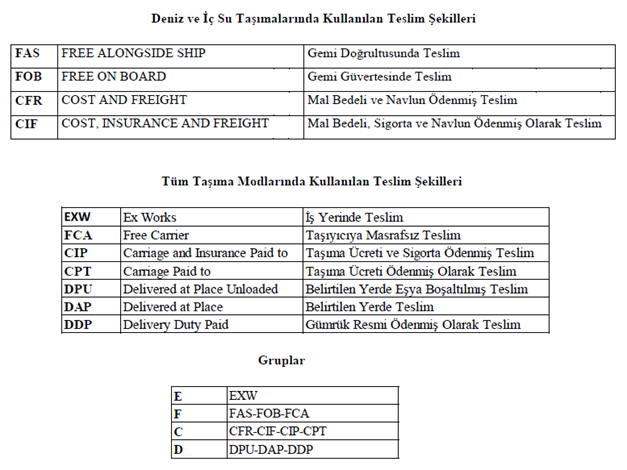Transportation is a key building block in both our daily lives and commercial operations. The logistics industry, whose impact we clearly witnessed during the Covid-19 pandemic, continues to develop with each passing day by incorporating digital integrations.
The fact that there are very short deadlines for order deliveries and the safe and easy operation that does not require face-to-face contact are considered as significant developments. Deep-rooted companies that follow the transportation of both small and tons of goods with the same care continue to stand strong. This type of system users are expected to most effectively manage storage, barcode readers, smart robots, digital mobile applications and supply chain links. When it comes to the crucial structure of international trade, which also affects the global economy, the delivery method of goods and the choices in the transportation model come to the fore. Even if goods are accepted by companies, the quality is appropriate, and the specified price is approved, misdelivery or defective delivery may have a negative impact on all relations between parties. The delivery methods reveal the entirety of the rules that determine the obligations of the parties in this regard. One can speak of issues such as customs procedures, the transportation process, insurance and tax within the perspective of the delivery method. The delivery method rules play a determining role in all of them, including where the shipped goods will be delivered, to which party the costs will be charged, which party will cover the damages incurred during transportation, and distinctions regarding loading and unloading.
Logistic transportation activities are determined in accordance with the terms of the agreement signed between parties, and the type of shipment. Incoterms 2020 is the latest version published by the International Chamber of Commerce (ICC).
Categorizing the International Delivery Methods into the groups of E, F, C and D facilitates the analysis. The delivery methods are categorized as sea/inland waterway transport (FAS, FOB, CFR, CIF) and any mode of transport (EXW, FCA, CPT, CIP, DPU, DAP, DDP). With respect to the delivery methods that many industry professionals are familiar with and which they include in their studies by continuously commenting on them, there are a number of important issues that are overlooked. When closer attention is paid to these critical points, details relating to the lifting of various obligations of parties and understanding which party will be held accountable become clearer. For example, the model that was previously known as DAT (Delivered at Terminal) is now called DPU (Delivered at Place Unloaded) in Incoterms 2020. The DPU delivery method has essentially been brought to the fore in a manner that encompasses the DAT model. DPU refers to the delivery and unloading of goods in the recipient’s country and in the destination specified by the recipient. In the DAT model, the ultimate point of delivery is the terminal, whereas in the DPU model, this destination can be any place determined by the recipient. This can be any place, including the depot, terminal or factory. In the FCA delivery method, the seller fulfills their responsibilities once they deliver the goods under the supervision of the carrier after completing customs procedures. Especially during ship loading, the seller fulfills their obligation by delivering the goods to the carrier. However, it is not always possible to load the ship at its full capacity and carry out this process seamlessly. For this reason, the fact that the bank expects a bill of lading from the seller creates quite a serious problem. Incoterms 2020 has made it possible for the carrier to issue a bill of lading containing the loading date to the seller through the instruction of the recipient after the goods are loaded onto the ship. In this case, the process is able to proceed as expected once the seller sends a bill of lading to the recipient through banks.
In all delivery methods included in the E, F and C groups, the legal point of delivery of the goods belongs to the place of exit. In the delivery methods included in these groups, the delivery does not belong to the country of destination. Moreover, for the delivery methods in the E and F groups, it is not the seller who makes an agreement with the carrier company and covers the freight expense; the recipient is directly responsible. FOB and CFR are the most frequently used delivery methods. Especially in FOB, it is generally the seller who arranges the shipping company; however, the rule indicates the exact opposite. In EXW, on the other hand, the seller is obliged to prepare the goods for loading. However, they do not have to perform customs procedures, and they are not responsible for loading the goods onto the vehicle. In order to facilitate the procedures, the seller can undertake such procedures; however, it is crucial that the parties are aware of these issues. In the C group delivery method, the seller is responsible until they deliver the goods in their own country. The seller is not legally obliged to carry out the delivery till the country of destination. However, the obligation may continue until the payment of the freight expenses if there is a port of destination. It is important that the responsibility for freight and the legal delivery obligation are not confused.
One of the most crucial points is the ability of companies that have been operating in the logistics industry for over twenty-five years in our country to rid themselves of their traditional structure and move forward with innovative perspectives. In this respect, Arkas Lojistik and its organizational chart are one of the exemplary models. Similar companies stand out with their combined sea/air/land/railway transport, open cargo and project transport, their complete digital integration of forwarding and depot services, and their ability to secure a valuable position by participating in global trade through expansion.
Overall, it must not be forgotten that delivery method rules are not laws, they are among the issues that must be implemented and that shape global trade, and as a whole, they clearly notify parties about legal points of delivery. If the seller and recipient are fully aware of their responsibilities, this will prevent instances in which one might say “I loaded the goods, I don’t have any more responsibilities” or “the goods have been loaded, we are waiting” in the shipping document.
It would be wrong to view delivery methods as just a cost item. Moreover, it is important to recognize that it clearly lays out the risks and responsibilities.
(I would like to extend my utmost gratitude to my distinguished professor Nihat Turhan, whose works I drew inspiration from in my study.)




